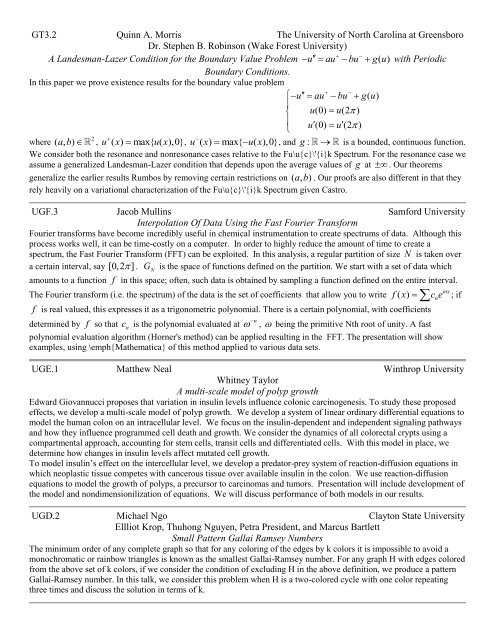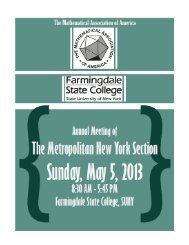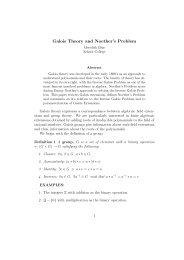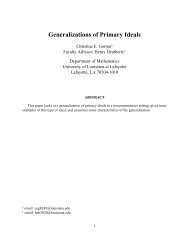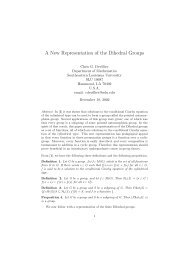Presentation Abstracts - MAA Sections
Presentation Abstracts - MAA Sections
Presentation Abstracts - MAA Sections
You also want an ePaper? Increase the reach of your titles
YUMPU automatically turns print PDFs into web optimized ePapers that Google loves.
GT3.2 Quinn A. Morris The University of North Carolina at Greensboro<br />
Dr. Stephen B. Robinson (Wake Forest University)<br />
A Landesman-Lazer Condition for the Boundary Value Problem u au <br />
bu g( u)<br />
with Periodic<br />
Boundary Conditions.<br />
In this paper we prove existence results for the boundary value problem<br />
<br />
u<br />
au bu g( u)<br />
<br />
u(0) u(2 )<br />
<br />
u(0) u(2 )<br />
2<br />
where ( ab , ) , u ( x) max{ u( x),0}<br />
, u ( x) max{ u( x),0}<br />
, and g : is a bounded, continuous function.<br />
We consider both the resonance and nonresonance cases relative to the Fu\u{c}\'{i}k Spectrum. For the resonance case we<br />
assume a generalized Landesman-Lazer condition that depends upon the average values of g at . Our theorems<br />
generalize the earlier results Rumbos by removing certain restrictions on ( ab , ) . Our proofs are also different in that they<br />
rely heavily on a variational characterization of the Fu\u{c}\'{i}k Spectrum given Castro.<br />
UGF.3 Jacob Mullins Samford University<br />
Interpolation Of Data Using the Fast Fourier Transform<br />
Fourier transforms have become incredibly useful in chemical instrumentation to create spectrums of data. Although this<br />
process works well, it can be time-costly on a computer. In order to highly reduce the amount of time to create a<br />
spectrum, the Fast Fourier Transform (FFT) can be exploited. In this analysis, a regular partition of size N is taken over<br />
a certain interval, say [0,2 ] . G is the space of functions defined on the partition. We start with a set of data which<br />
N<br />
amounts to a function f in this space; often, such data is obtained by sampling a function defined on the entire interval.<br />
inx<br />
The Fourier transform (i.e. the spectrum) of the data is the set of coefficients that allow you to write f ( x)<br />
cne<br />
; if<br />
f is real valued, this expresses it as a trigonometric polynomial. There is a certain polynomial, with coefficients<br />
n<br />
determined by f so that c<br />
n<br />
is the polynomial evaluated at , being the primitive Nth root of unity. A fast<br />
polynomial evaluation algorithm (Horner's method) can be applied resulting in the FFT. The presentation will show<br />
examples, using \emph{Mathematica} of this method applied to various data sets.<br />
<br />
UGE.1 Matthew Neal Winthrop University<br />
Whitney Taylor<br />
A multi-scale model of polyp growth<br />
Edward Giovannucci proposes that variation in insulin levels influence colonic carcinogenesis. To study these proposed<br />
effects, we develop a multi-scale model of polyp growth. We develop a system of linear ordinary differential equations to<br />
model the human colon on an intracellular level. We focus on the insulin-dependent and independent signaling pathways<br />
and how they influence programmed cell death and growth. We consider the dynamics of all colorectal crypts using a<br />
compartmental approach, accounting for stem cells, transit cells and differentiated cells. With this model in place, we<br />
determine how changes in insulin levels affect mutated cell growth.<br />
To model insulin’s effect on the intercellular level, we develop a predator-prey system of reaction-diffusion equations in<br />
which neoplastic tissue competes with cancerous tissue over available insulin in the colon. We use reaction-diffusion<br />
equations to model the growth of polyps, a precursor to carcinomas and tumors. <strong>Presentation</strong> will include development of<br />
the model and nondimensionilization of equations. We will discuss performance of both models in our results.<br />
UGD.2 Michael Ngo Clayton State University<br />
Ellliot Krop, Thuhong Nguyen, Petra President, and Marcus Bartlett<br />
Small Pattern Gallai Ramsey Numbers<br />
The minimum order of any complete graph so that for any coloring of the edges by k colors it is impossible to avoid a<br />
monochromatic or rainbow triangles is known as the smallest Gallai-Ramsey number. For any graph H with edges colored<br />
from the above set of k colors, if we consider the condition of excluding H in the above definition, we produce a pattern<br />
Gallai-Ramsey number. In this talk, we consider this problem when H is a two-colored cycle with one color repeating<br />
three times and discuss the solution in terms of k.


